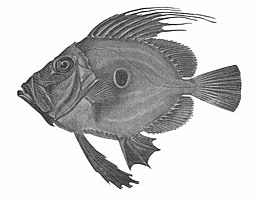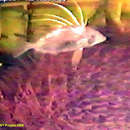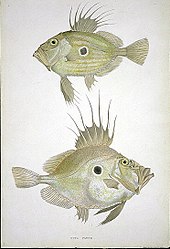Benefits
provided by FAO species catalogs
Reported to be rather abundant off Morocco, Senegal and Madeira. The 1978 catch reported for this species from the fishing area 34 and fishing area 47 (Eastern central Atlantic) 493 t (Morocco, 105; U.S.S.R., 287 t; Portugal, 78 t; Japan, 23 t). Caught mainly with bottom trawls. Is an excellent foodfish, marketed fresh, frozen, dried salted and smoked. Also used for fishmeal and oil by industrial offshore fishing fleets.
Brief Summary
provided by FAO species catalogs
Mesopelagic and demersal behaviour. Either near the bottom or in midwater, from the coast to at least 400 m depth, but more common between 20 and 160 m.Mainly in coastal waters.A poor swimmer, generally solitary.Feeds on a wide range of fishes, especially schooling and demersal species. Sometimes also cephalopods and crustaceans (alpheid, pandalid and palaemonid). Reproduction takes place at the end of winter and at the start of spring in the northeastern Atlantic (June-August in Bay of Biscay, western part of English Channel, see Quero, 1986).
Size
provided by FAO species catalogs
Maximum 65 cm; common to 40 cm.
Distribution
provided by FAO species catalogs
Worldwide distribution. Eastern Atlantic from Norway to South Africa (overlaps with Zeus capensis), including Azores, Madeira and Canary Islands, also Mediterranean and Black Sea. Known from Indian and Western Pacific Ocean as well (Australia, New Zealand, Japan and Korea, see Heemstra, 1980).
Diagnostic Description
provided by FAO species catalogs
Body deep and strongly compressed. Caudal peduncle about as long as deep. Head large, its upper profile straight or convex. Eye moderate in size, contained about 3 or 4 times in head. Mouth large and oblique, jaws massive. Gill rakers rudimentary. Dorsal fin with 9 or 11 spines and 21 to 25 soft rays; the spinous portion with filaments about as long as the spines. Anal fin with 4 (rarely 3 to 5) spines and 20 to 24 soft rays. Pelvic fins inserted about below posterior eye margin. Body apparently naked (covered with very small scales not visible without magnification), but spined scutes present along the bases of dorsal (5 to 10) and anal (6 to 11) fins. Bony plates also present on midventral profile. Colour golden greenish grey with a conspicuous ocellus (a black or dark blue spot encirled by a narrow greyish or yellowish border on middle of side). Fin membrane of spinous dorsal fin dark, those of the spinous anal and pelvics black.
- Cuvier, G. & A. Valenciennes - 1835. Histoire naturelle des poissons. Tome dixième. Suite du livre neuvième. Scombéroïdes. Livre dixième. De la famille des Teuthyes. Livre onzième. De la famille des Taenioïdes. Livre douzième. Des Athérines. v. 10: i-xxiv + 1-482 + 2 pp., Pls. 280-306. Valenciennes authored volume. i-xix + 1-358 in Strasbourg edition.
- Desbrosses, P. - 1937. Sur le Saint-Pierre de Mauritanie, du Sénégal et de Guinée. Nouvelle race locale. Zeus faber L. mauritanicus (natio nova). Rev. Trav. Inst. Peches Marit. v. 10 (no. 3): 379-409.
- Dieuzeide, R., M. Novella & J. Roland - 1954. Catalogue des Poissons des côtes algériennes. Bull. Stn Aquic. Pêch. Castiglione II (n.s.) . 5: 1-258, 135 fig. N. num.
- Heemstra, P. C. - 1980. A revision of the zeid fishes (Zeiformes: Zeidae) of South Africa. Ichthyol. Bull. J. L. B. Smith Inst. Ichthyol. No. 41: i-iii + 1-18, Pls. 1-2.
- J.-C. Quero - 1981. Zeidae In: W. Fischer, G. Bianchi and W. Scott (eds). FAO species identification sheets for fishery purposes. Eastern Central Atlantic; fishing areas 34, 47 (in part). Canada Funds-in-Trust. Ottawa, Department of Fisheries and Oceans Canada, by arrangement with the Food and Agriculture Organization of the United Nations . vol. IV : pag. var.
- Karrer, C. & A. Post - 1990. Zeidae In: J.C. Quero, J.C. Hureau, C. Karrer, A. Post and L. Saldanha (eds). Check-list of the fishes of the eastern tropical Atlantic (CLOFETA). JNICT-Portugal, SEI-France, Unesco. Vol. II: 631 - 633 .
- Lloris, D. - 1986. Ictiofauna demersal y aspectos biogeográficos de la costa sudoccidental de África (SWA/Namibia). Monogr. Zool. Mar. I: 9-432, 228 figs., tab. I-CCI.
- Quero, J.-C. - 1986. Zeidae In: P.J.P. Whitehead, M.-L. Bauchot, J.-C. Hureau, J. Nielsen and E. Tortonese (eds). Fishes of the North-eastern Atlantic and the Mediterranean (FNAM). Unesco, Paris. Vol. II: 769-772.
- Richardson, J. - 1844-48. Ichthyology of the voyage of H. M. S. Erebus and Terror.. In: J. Richardson and J. E. Gray. The zoology of the voyage of H. H. S. "Erebus and Terror", under the command of Captain Sir J. C. Ross .. during .. v. 2 (2): i-viii + 1-139, Pls. 1-60. [1844: 1-16; 1845: 17-52; 1846: 53-74; 1848: i-viii + 75-139.]. London.
- Wheeler, A. - 1973. Zeidae In: J.-C. Hureau and Th. Monod (eds). Check-list of the fishes of the north-eastern Atlantic and of the Mediterranean (CLOFNAM). Unesco, Paris. Vol. I: 349-350.
Diagnostic Description
provided by Fishbase
Gill rakers rudimentary. Minute scales present. Highly compressed body (Ref. 4253). Large dark spot, surrounded by a light ring on each side of the body (Ref. 35388).
- Recorder
- Cristina V. Garilao
Life Cycle
provided by Fishbase
No studies of their reproductive development or early life history have been undertaken in Australia (Ref. 6390). Pelagic eggs (Ref. 35388).
Migration
provided by Fishbase
Oceanodromous. Migrating within oceans typically between spawning and different feeding areas, as tunas do. Migrations should be cyclical and predictable and cover more than 100 km.
Morphology
provided by Fishbase
Dorsal spines (total): 9 - 11; Dorsal soft rays (total): 22 - 24; Analspines: 4; Analsoft rays: 20 - 23
- Recorder
- Cristina V. Garilao
Trophic Strategy
provided by Fishbase
Inhabits sandy and muddly areas in the deep. Found in areas close to the sea bed (Ref. 6390). Generally solitary. Feeds mainly on schooling bony fishes, occasionally on cephalopods and crustaceans (Ref. 27121).
Biology
provided by Fishbase
Found in areas close to the sea bed (Ref. 6390). Generally solitary. Feeds mainly on schooling bony fishes, occasionally on cephalopods and crustaceans (Ref. 27121). Reproduction takes place at the end of winter and at the start of spring in the northeastern Atlantic, earlier in the Mediterranean. Eggs are pelagic, maturity reached at 4 years (Ref. 36731). Sold fresh (Ref. 9563) and frozen (Ref. 9988). Can be steamed, fried, broiled, boiled, microwaved and baked (Ref. 9988). The flesh is excellent but is utilized little in West Africa (Ref. 5377).
Importance
provided by Fishbase
fisheries: commercial; gamefish: yes; aquarium: public aquariums
Comprehensive Description
provided by Smithsonian Contributions to Zoology
Zeus faber
Zenopsis conchifer ventral view of isthmus to anus
Cyttus traversi above C. novaezelandiae ventral view of isthmus to anus
- bibliographic citation
- Tyler, James C., O'Toole, Bruce, and Winterbottom, Richard. 2003. "Phylogeny of the genera and families of Zeiform fishes, with comments on their relationships with tetraodontiforms and caproids." Smithsonian Contributions to Zoology. 1-110. https://doi.org/10.5479/si.00810282.618
分布
provided by The Fish Database of Taiwan
廣泛分布於世界各大海域。除了東部海域,臺灣各地皆有分布。
利用
provided by The Fish Database of Taiwan
中大型魚類,常為底拖網捕獲,肉道鮮美,具食用價值。
描述
provided by The Fish Database of Taiwan
體高而側扁,橢圓形,頭背呈微外凸緣線,腹緣圓弧形。眼上側位。口大,口裂幾垂直,上頜可伸縮。上下頜齒小,腭骨則無齒。鰓耙退化呈瘤狀。體被細鱗,側線則完全,呈一管狀線。背鰭基部具9-12個骨板;臀鰭基部亦有5-8個;腹部則為具棘之鱗片。背鰭單一,硬棘部及軟條部間具一深刻,硬棘IX-XI,細長如絲,棘間具膜,軟條則具22-24;臀鰭硬棘IV,不延長如絲,軟條20-23;胸鰭短;腹鰭延長,後端達臀鰭起點之後;尾鰭截平。體銀灰色;體側中央具一約與眼徑等大的白緣藍黑色圓斑。
棲地
provided by The Fish Database of Taiwan
深海底層魚類,棲息深度在40-200公尺間的大陸棚斜坡或海床,以群居性之魚類及甲殼類為食。
John Dory
provided by wikipedia EN
John Dory, St Pierre or Peter's fish, refers to fish of the genus Zeus, especially Zeus faber, of widespread distribution. It is an edible demersal coastal marine fish with a laterally compressed olive-yellow body which has a large dark spot, and long spines on the dorsal fin. Its large eyes at the front of the head provide it with binocular vision and depth perception, which are important for predators. The John Dory's eye spot on the side of its body also confuses prey, which are scooped up in its big mouth.[3][4]
In New Zealand, Māori know it as kuparu, and on the East Coast of the North Island, they gave some to Captain James Cook on his first voyage to New Zealand in 1769. Several casks of them were pickled.[3]
Name
Various, often doubtful explanations are given of the origin of the name. It may be an arbitrary or jocular variation of dory (from French dorée, gilded), or an allusion to John Dory, the hero of an old ballad. Others suggest that "John" derives from the French jaune, yellow. The novel An Antarctic Mystery by Jules Verne gives another account, which has some popularity but is probably fanciful: "The legendary etymology of this piscatorial designation is Janitore, the 'door-keeper,' in allusion to St. Peter, who brought a fish said to be of that species, to Jesus at his command." Other known names for the John Dory are the "St. Pierre", or "Peter's Fish", perhaps explaining why dories were often referred to as "Peter Boats", Saint Peter being the patron saint of fishermen.[5] A related legend says that the dark spot on the fish's flank is St. Peter's thumbprint.[6] In the north coast of Spain, it is known commonly as San Martiño.
Morphology
The John Dory grows to a maximum size of 65 cm (2 ft) and 5 kg (12 lb) in weight. It has 10 long spines on its dorsal fin and 4 spines on its anal fin. It has microscopic, sharp scales that run around the body. The fish is an olive green color with a silver white belly and has a dark spot on its side. Its eyes are near the top of its head. It has a flat, round body shape and is a poor swimmer.
Prey and predators
The John Dory catches prey by stalking it, then extending its jaw forward in a tube-like structure to suck the fish in with some water. The water then flows out through the gills; the pre-maxillary bone, the only tooth-bearing bone in this fish, is used to grind the food.
The John Dory has a high laterally compressed body – its body is so thin it can hardly be seen from the front. The large eyes at the front of the head provide it with the binocular vision and depth perception it needs to catch prey. This eye spot also confuses prey, which can then be sucked into its mouth.[7]
It primarily eats smaller fish, especially schooling fish such as sardines. Occasionally it eats squid and cuttlefish.
Its main predators are sharks such as the dusky shark, and large bony fish.
Habitat
John Dory are benthopelagic coastal fish, found on the coasts of Africa, South East Asia, New Zealand, Australia, the coasts of Japan, and on the coasts of Europe. They live near the seabed, living in depths from 5 to 360 metres (16 to 1,200 ft). They are normally solitary.
Reproduction and lifespan
When John Dories are 3 or 4 years of age, they are ready to reproduce. This happens around the end of winter. They are substrate scatterers, which means that they release sperm and eggs into the water to fertilize. Typical lifespan is about 12 years in the wild.
As food
The cookery writer Eliza Acton observes in her 1845 book, Modern Cookery for Private Families, that John Dory "though of uninviting appearance, is considered by some person(s) as the most delicious fish that appears at [the] table". She recommends simply baking it "very gently", avoiding drying it out in the oven.[8]
References
-
^ Sepkoski, Jack (2002). "A compendium of fossil marine animal genera". Bulletins of American Paleontology. 363: 1–560. Archived from the original on 2011-07-23. Retrieved 2007-12-25.
-
^ Iwamoto, T. (2015). "Zeus faber". IUCN Red List of Threatened Species. 2015: e.T198769A42390771. Retrieved 2 November 2021.
-
^ a b New Zealand Coastal Fish: John Dory.
-
^ Bray, Dianne. "John Dory, Zeus faber". Fishes of Australia. Archived from the original on 6 April 2017. Retrieved 24 August 2014.
-
^ see 1:Charlotte Mary Yonge, History of Christian names, Volume 1, pg. 359// 2: Abraham Smythe Palmer "Folk Etymology; Verbal Corruptions Or Words Perverted In Form Or Meaning pg. 196// 3.David Badham, Prose halieutics: or, Ancient and modern fish tattle/ 4: American Notes and Queries, Volume 3 pg. 129// and 5: Fraser's Magazine For Town And Country, January To June 1853
-
^ The legend is noticed in Stéphan Reebs, Fish Behavior in the Aquarium and in the Wild (Cornell 1991:36); Reebs notes that the fish does not occur in the Sea of Galilee, where Peter fished.
-
^ Walrond, Carl (2006) Coastal fish - Fish of the open sea floor, Te Ara: Encyclopedia of New Zealand. Accessed 28 May 2019.
-
^ Acton, Eliza (1860) [1845]. Modern Cookery for Private Families. Longman, Green, Longman, & Roberts. p. 58.
- license
- cc-by-sa-3.0
- copyright
- Wikipedia authors and editors
John Dory: Brief Summary
provided by wikipedia EN

John Dory, Zeus faber
John Dory, St Pierre or Peter's fish, refers to fish of the genus Zeus, especially Zeus faber, of widespread distribution. It is an edible demersal coastal marine fish with a laterally compressed olive-yellow body which has a large dark spot, and long spines on the dorsal fin. Its large eyes at the front of the head provide it with binocular vision and depth perception, which are important for predators. The John Dory's eye spot on the side of its body also confuses prey, which are scooped up in its big mouth.
In New Zealand, Māori know it as kuparu, and on the East Coast of the North Island, they gave some to Captain James Cook on his first voyage to New Zealand in 1769. Several casks of them were pickled.
- license
- cc-by-sa-3.0
- copyright
- Wikipedia authors and editors
Description
provided by World Register of Marine Species
Generally solitary. Feeds on fish (esp. schooling and demersal species), cephalopods, and crustaceans (Ref. 5213). Sold fresh in Australia and fetches a high market price (Ref. 9563), also marketed frozen (Ref. 9988). Can be steamed, fried, broiled, boiled, microwaved and baked (Ref. 9988).
Froese, R. & D. Pauly (Editors). (2023). FishBase. World Wide Web electronic publication. version (02/2023).
- license
- cc-by-4.0
- copyright
- WoRMS Editorial Board



 John Dory, Zeus faber
John Dory, Zeus faber